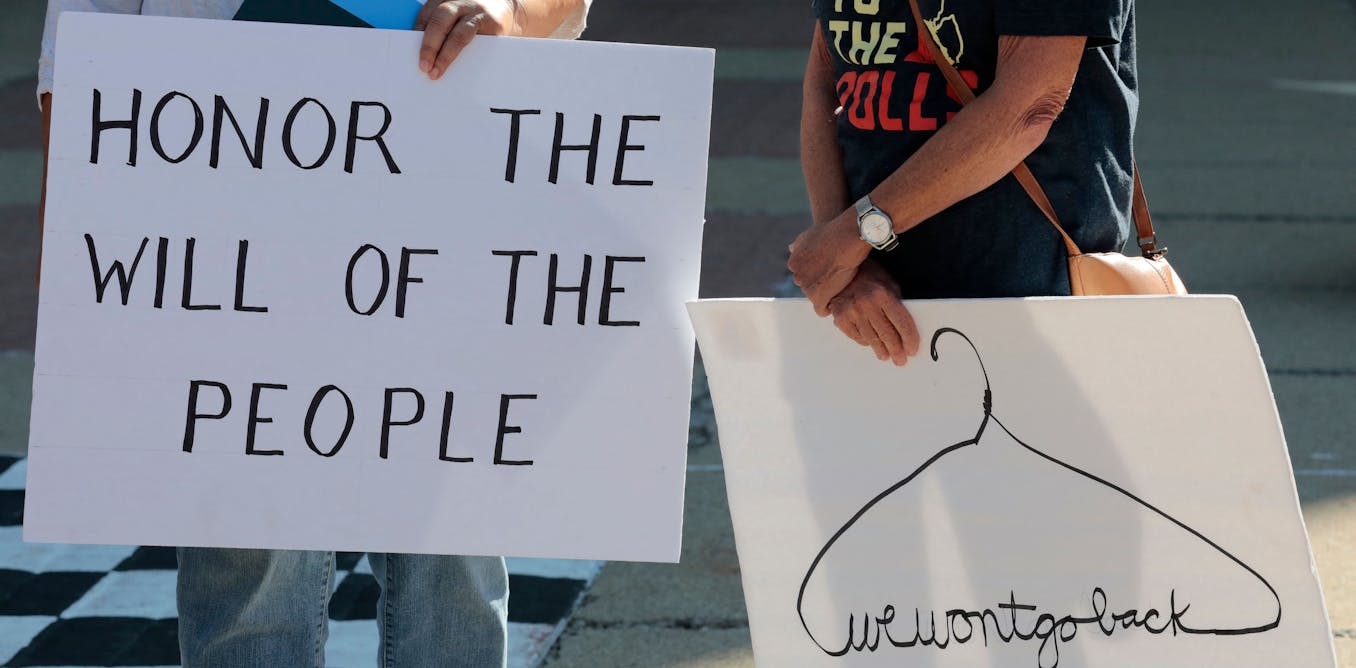Direct democracy can force governments to better represent the people — but it doesn’t always work out


In August 2022, a statewide referendum in Kansas saw citizens overwhelmingly reject a plan to insert anti-abortion language into the state’s constitution. It comes as a slew of similar votes on abortion rights are planned in the coming months – putting the issue directly to the people after the Supreme Court struck down the landmark Roe v. Wade ruling.
But are referendums and citizens initiatives good for democracy? It may seem like an odd question to pose, especially at a time when many feel democracy is imperiled both in the U.S. and around the world.
As someone who researches democracy, I know the answer isn’t simple. It depends on the kind of initiative and the reason that it comes to be held.
First, some simple distinctions. Referendums and citizens initiatives are mechanisms of direct democracy – instances in which members of the public vote on issues that are commonly decided, in representative systems, by legislatures or governments. While with referendums it is typically the government that places questions on the ballot, with citizens initiatives – more common at the state level in the U.S. – the vote originates outside of government, usually through petition drives.
The Chicago Center on Democracy, which I lead at the University of Chicago, recently launched a website that tracks many of these direct democracy efforts over the past half-century.
Appealing to the masses or settling scores
That a majority of democracies retain some form of direct democracy is a testament to the legitimacy with which citizens’ voices are heard, even when, in fact, most decisions are made by our elected leaders. Often, national governments call referendums to bring important questions directly to its citizens.
But why would governments ever decide to turn a decision over to the people?
In some cases, they have no choice. Many countries, among them Australia, require that constitutional amendments be approved in popular referendums.
In other instances, such votes are optional. United Kingdom Prime Minister David Cameron, for example, was under no obligation to undertake a 2016 referendum on continued EU membership. Colombian President Juan Manuel Santos had plenty of legislative support that same year to ratify peace accords with a rebel group through an act of congress. But he turned the decision over to the people, instead.
 Pushing a Brexit referendum backfired on then-Prime Minister David Cameron. Brian Lawless/PA Images via Getty Images
Pushing a Brexit referendum backfired on then-Prime Minister David Cameron. Brian Lawless/PA Images via Getty Images
One reason leaders voluntarily put important issues before voters is to solve disputes within their own political parties. The Brexit vote is a case in point. The U.K. Conservative Party was deeply divided over British membership in the EU, and – as Cameron later acknowledges in his memoirs – his position as head of the party, and thus as prime minister, was increasingly threatened.
In these instances, the government is in effect using the people as a referee to decide an internal dispute. It is a high-risk move, though. For Cameron, going to the country meant the end of his premiership. And six years on, the U.K. is still dealing with the fallout of that vote.
Sometimes leaders seek public support on issues about which they expect powerful opposition upon implementation. Colombia’s Santos expected resistance to the peace deal from opponents, including wealthy landed interests. He used the people as a kind of force field to protect the policy. But again, the strategy backfired. The Colombian accords were defeated, and have since faced powerful resistance when subsequent attempts were made to implement them through legislative approval.
But do these two high-profile instances illustrate fatal flaws in referendums, and direct democracy in general? Perhaps not.
Though plenty of disinformation circulated before both votes, the results probably fairly accurately reflected the people’s preferences. Moreover, they illustrate the perils to political leaders of placing issues of crucial importance before voters – they can’t be sure they will like the results.
And when their referendums fail, they may set back causes that these politicians care about. For example, Brazil held a referendum on gun control in 2005. It failed, and later pro-gun rights President Jair Bolsonaro used its failure to try to loosen restrictions on firearms, claiming that the failure of the referendum allowed him to do so.
Tool of demagogues
Sometimes the prime minister or president does prevail. A kind of referendum was used in Australia in 2017 to pressure the legislature into legalizing same-sex marriage. Conservative politicians were willing to hold a vote, with the same kind of “referee logic” as in Brexit – they were opposed to same-sex marriage, but preferred to go along with the public’s will, rather than continue to fight over this internally divisive issue.
In the end, the pro-marriage equality prime minister opted for a “postal survey” rather than a formal referendum. And the gamble worked for Australia’s leader – a very large majority expressed support of same-sex marriage and the prime minister got his way.
For every Colombia-style debacle, in which a leader holds an optional referendum but fails, one can point to governments putting matters to a popular vote to produce a force field, and winning. The approval of the public can make policy immune to – or at least undermine – later opposition. Such was the case of same-sex marriage in Ireland, passed by referendum in 2015. The following year, Ireland settled the issue of abortion access, overturning a ban by a two-thirds majority.
Referendums are not only used by democratic leaders but also by autocrats and demagogues. Russian President Vladimir Putin put a series of constitutional reforms before voters in 2020, including one that overturned Putin’s prior term limit in office.
Accusations of fraud and intimidation followed the vote. The process could hardly have been more at odds with direct democracy and the autonomous expression of the people’s will.
Getting policy to line up with people’s will
There are no national referendums in the U.S. But American voters have a great deal of experience with initiatives at the state level – and with statewide referendums, as well. These votes have the potential to force governments to abide by the people’s will in cases where legislators may be resisting popular policies.
Yet problems can arise with these exercises in direct democracy. Even though they are presumably citizens initiatives, the influence of political parties, special interests, lobbyists and big money can turn them into something quite different, as was the experience of California in the 1990s – which in turn undermined the public’s satisfaction in the initiative process.
But recently we have seen a spate of state initiatives that seem more promising – where majorities of citizens are demanding that their state legislatures bring policy more in line with public opinion. Florida voters approved ex-felon voting; Arizona voters approved bigger budgets for public schools; Missouri voters forced a reluctant legislature to expand Medicare in their state. All of these initiatives were backed with popular public support.
Most recently, Kansans said “no,” in referendum, to inserting pro-life language into their state´s constitution.
‘Let the people decide!’
The potential for mechanisms of direct democracy to improve citizen representation depends on the context in which they are held, including the manner in which they are placed on the ballot and the motives of those who placed them there.
At one extreme are autocrats like Putin who held votes that augment his power and the length of his term. At the other are citizens frustrated by legislators whose actions stray far from public opinion. In between are measures sponsored by governments that may want to insulate policies they care about with the help of the people’s backing, and parties that throw their hands up, in the context of internal divisions, and say, “Let the people decide.”





